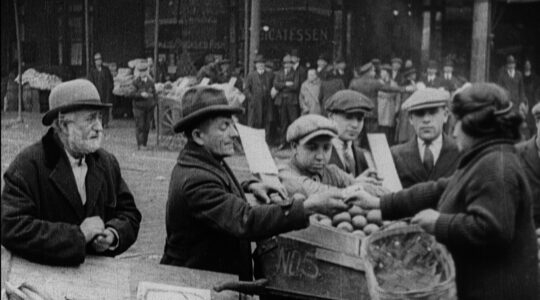For decades, my extended family’s seders consisted of an abridged reading of a 1970s Haggadah that, while in English, was neither accessible nor inspiring.
Two years ago, my older daughter, then 5 and obsessed with Dreamworks’ “The Prince of Egypt,” complained that we had gone through the whole pre-dinner reading without fully telling the story of Moses and the Exodus.
So last year, she and I took over the seder-leading and put together our own Haggadah: an illustrated narration of the story, surrounded by the blessings, explanations of the various rituals and a few contemporary readings about freedom.
My daughter was so proud and excited about our Haggadah that she sat attentively for the entire reading, even after the other kids had slipped off to play.
There is obviously no shortage of ready-made Haggadot available for purchase. Thousands of different editions have been published over the years, and an Amazon.com search turns up a staggering 822 results.
However, there’s something to be said for assembling your own, a project that can be a one-person job or involve contributions from the entire family.
“It’s a great way to make it meaningful for you,” says Dasee Berkowitz, the founder and lead consultant of JLife Consulting, which helps individuals learn about and prepare for lifecycle ceremonies.
For years, Berkowitz, who lives in Sag Harbor, L.I., and her sister have worked together to create a family Haggadah, which includes photos, artwork and writing by the children. They put in a loose-leaf binder “so we can continue to add to it each year.”
“There’s a great balance between having the ancient text everyone is familiar with but also the ability to improvise and create meaning that is relevant to you and your family,” says Eileen Levinson, the founder of Haggadot.com (see below).
Haggadot are not the only Jewish books that lend themselves to DIY-ers. Aided by sites like The Open Siddur Project, some families design their own siddurs, especially for bar/bat mitzvah ceremonies, and a number of groups have created their own bentschers, the booklets of Shabbat songs and Birkat Hamazon, the grace after meals.
Jewish Milestones, a nonprofit in Berkeley, Calif., is in the early stages of developing a customizable book of prayers, meditations and photos for people confronting major illness.
“The revolution in technology and the capacity for print-on-demand, along with the interactive possibilities, has absolutely tipped it towards a trend,” says Rachel Brodie, Milestones’ executive director. “Also, it dovetails really nicely with how individually and personally people are managing their own spiritual/religious lives now.”
While many seder hosts, including journalists Steve and Cokie Roberts (see interview here), have long typed, photocopied and stapled (or like Berkowitz, used loose-leaf binders) to create homemade versions, several new tools make the process easier and more aesthetically appealing:
The recipient of a $60,000 Jewish New Media Innovation Fund grant, the newly launched Haggadot.com allows users to pick and choose from hundreds of images and commentaries on the text to create their own, personalized Haggadah.
Users can also upload their own commentaries and images, as well as scans of old Haggadot.
“It’s one big Passover conversation” taking place online, says Eileen Levinson, who began developing Haggadot.com four years ago as a graphic design graduate student at the California Institute of the Arts.
Currently, you can search for artwork and commentaries on the Haggadah by “style”: Orthodox, Conservative, Reform, GLBT, Sephardic, Feminist, Interfaithm and others. However, that will soon change.
“We realized that it’s contradictory to what we were trying to do,” Levinson says. “It’s much more hybridized; commentary by a Conservative rabbi doesn’t mean that the commentary is exclusive to Conservative Jews. There’s a lot more crossing over between categories.”
The revamped website will allow users to search by ritual (the traditional text), commentary (explanations of the text), and images.
Right now, the site is a bit clunky and dragging content into your virtual Haggadah takes some skill. Levinson acknowledges these limitations and says that she hopes to fix them.
For next Passover, Levinson hopes to partner with a print-on-demand publisher to allow users to print as many copies as they need at a relatively low cost. In the meantime, users can download their Haggadot and print them at home.
The Behrman House Family Haggadah
A publisher best known for its textbooks and educational materials, Behrman House recently adapted its 10-year-old “Family Haggadah,” enabling users to customize it, yet also end up with a professionally bound and printed product. (April 8 is the order deadline to have a Haggadah ready by the first night of Passover.)
Unlike Haggadot.com, which allows users to choose every page and section, the customizable “Family Haggadah” keeps much of the original text unchangeable yet offers about 50 places where users can add images and texts.
President David Behrman describes it as a “good balance between authoritative content and customized family meaning.”
“For most Jewish families, the notion of doing all the learning — of completely customizing the whole experience — is pretty daunting,” he says, noting that users of the Behrman Haggadah “can do as little or as much work as they want to make it the kind of experience they’d like to have.”
Up to six guests can log on to help edit the Haggadah.
While more expensive than most ready-made Haggadahs (prices range from $11.95 to $22.95 per copy depending on the size of the order), Behrman says customization “takes the experience to a different level.”
“People can make customized calendars, T-shirts and mugs in the secular world,” he says. “We think it’s time that the Jewish world offers similar opportunities, particularly with respect to the celebration of holidays and lifecycle events.”
(Available at www.behrmanhouse.com)
My Haggadah: Made It Myself
Francine Hermelin Levite, a graphic designer and mother of three, has long been a fan of the “Anti-Coloring Book” series, books that encourage children not just to color, but also to create their own artwork.
Hermelin Levite’s somewhat quirkily illustrated Haggadah ($18 for a PDF you can print yourself or $22 for a printed copy with stickers) has a similar sensibility, with each page suggesting a different activity or issue to think about. A page about the seder plate suggests readers draw each item that goes on the plate, but also leaves an extra spot for them to add a new symbol “that reflects your values.” The Exodus narration includes outlines of Moses and Pharoah, suggesting that users draw faces for them and write words for them in a speech bubble.
“Passover is all about dialogue between parents and children, and I wanted to create a book that would do that,” she says.
First developed seven years ago for the Jewish Community Project downtown, “My Haggadah: Made It Myself” can be used as a supplement or pre-seder education tool. However, it contains all the standard elements of a Haggadah, so everyone at the table can use one, filling it in either before or during the seder, depending on the family’s level of observance.
(Available only at http://madeitmyselfbooks.wordpress.com)
Tamar Snyder contributed reporting to this article.
The New York Jewish Week brings you the stories behind the headlines, keeping you connected to Jewish life in New York. Help sustain the reporting you trust by donating today.




